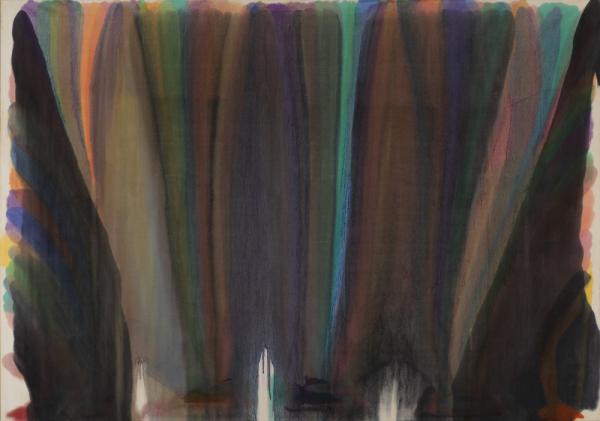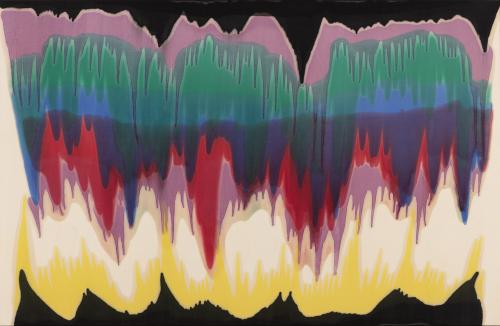Skip to main content
Dalet Kaf
Artist
Morris Louis
(Born 1912, United States; died 1962, United States)
Date1959
MediumAcrylic resin (Magna) on canvas
DimensionsUnframed: 100 5/8 x 143 in. (255.59 x 363.22 cm)
Framed: 101 3/4 x 143 3/4 x 2 1/8 in. (258.45 x 365.13 x 5.4 cm)
Framed: 101 3/4 x 143 3/4 x 2 1/8 in. (258.45 x 365.13 x 5.4 cm)
Credit LineCollection of the Modern Art Museum of Fort Worth, Museum purchase made possible by a grant from The Burnett Foundation
Object number1986.5
Status
Not on viewCopyright© 2020 Morris Louis / Artists Rights Society (ARS), New York
Category
Label TextMorris Louis is best known for his “stain” paintings, which he made by pouring a mixture of paint and turpentine directly onto unsized and unstretched canvases that he would then tilt and manipulate to create abstract shapes and fields of color. From 1954 to 1959, he used the stain method to create his Veil series, which marked the beginning of his mature style. The Museum’s Dalet Kaf, 1959, with its shimmering surface of layered “curtains” or “wings” of semi-transparent color, is a key painting within this body of work. All along its perimeter, areas of unprimed canvas are exposed, offering small breaks of openness, or breathing spaces.
The first artist to pour pigment onto unsized canvas was Louis’s peer Helen Frankenthaler, one of the few women to achieve contemporary recognition within the Abstract Expressionist movement. In 1953, Louis and the painter Kenneth Noland visited Frankenthaler’s studio in Washington, DC, where they were inspired by her Mountains and Sea, 1952 (National Gallery of Art, Washington, DC), a landmark “soak-stained” painting often considered to be a forerunner of the late 1950s and early 1960s Color Field movement. Championed by the influential critic Clement Greenberg, Louis, Noland, and others associated with Color Field painting sought to make works that emphasized the two-dimensional flatness of the picture plane by directly staining the canvas, thus unifying the medium of paint with its horizontal ground.
The first artist to pour pigment onto unsized canvas was Louis’s peer Helen Frankenthaler, one of the few women to achieve contemporary recognition within the Abstract Expressionist movement. In 1953, Louis and the painter Kenneth Noland visited Frankenthaler’s studio in Washington, DC, where they were inspired by her Mountains and Sea, 1952 (National Gallery of Art, Washington, DC), a landmark “soak-stained” painting often considered to be a forerunner of the late 1950s and early 1960s Color Field movement. Championed by the influential critic Clement Greenberg, Louis, Noland, and others associated with Color Field painting sought to make works that emphasized the two-dimensional flatness of the picture plane by directly staining the canvas, thus unifying the medium of paint with its horizontal ground.








